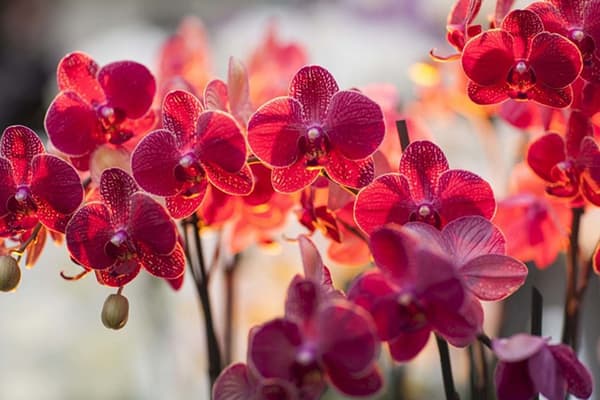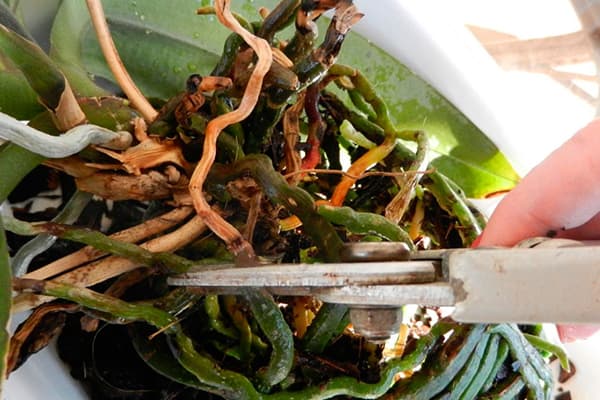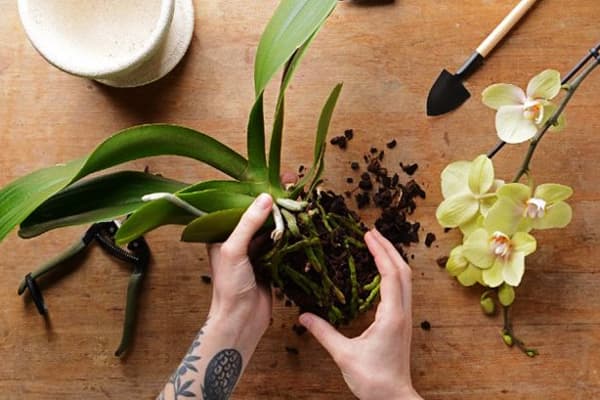Is it possible to transplant an orchid when it blooms?
Content:
With the advent of flowers, any plant becomes especially vulnerable and moody. To answer the question of whether it is possible to transplant an orchid during flowering, it is necessary to evaluate the possible benefits and harms. In one situation, it will be better to change the substrate and the pot, in another - wait until the pet dawns. It should be understood that transplantation is always associated with risk. A flowering plant needs a careful and careful attitude. If it is decided to transplant it, all the rules should be strictly observed.
When is it not worth transplanting an orchid?
Very often, the idea of transplanting an orchid arises from scratch. For example, after viewing photographs of the most beautiful specimens strewn with flowers, or a read article about the nuances of care or diseases of the species. One seems that the pot for the orchid has become small, the other - that it is time to change the substrate. In such cases, the plant should not be transplanted while it is blooming. A transplant needs a much more compelling reason.
In addition to the availability of evidence, you need to consider the time of year. A transplant in the autumn-winter period, also during flowering, with a 50% probability will end in the death of the plant. The fault is due to poor lighting due to the short daylight hours, lack of heat and the biological rhythm of the flowers. In winter, all living things fall asleep and practically do not grow. It is better to transplant indoor flowers in early spring or early summer.
Indications for transplanting a flowering plant
Connoisseurs of the Phalaenopsis orchid are advised not to touch the plant once again so as not to harm it. With these indoor flowers, as they say, it is better to "under" than "re" (underestimate, under-complete, etc.).
Indications for transplanting a flowering orchid are as follows:
- rotting of the root system;
- detection of cobwebs, midges or insect eggs in the substrate.
In this case, you need to look at the condition of the plant as a whole. A few dead roots are a variant of the norm. If the orchid is actively blooming, its leaves look healthy and rot does not spread, it is better to postpone the transplant. Conversely, dropping flowers and leaves, the rapid deterioration of the appearance of the flower - all this suggests that measures should be taken immediately.
How to transplant an orchid?
When transplanting a flowering orchid with rotting roots or when pests are found in a pot, the flower stalk is cut off first and foremost. Even when cut off, it can stand in the water for a very long time - up to 2 months. If the plant transplant is mostly a whim, then the peduncle can be left. But not the fact that the inflorescences themselves will not fall.
Transplant Instructions:
- Prepare the substrate. Its basis should be pine bark (you can use only it). Additionally, sphagnum moss, fern roots, charcoal may be present in the soil. It is necessary to focus on good ventilation and friability of the substrate. Only large components, 1.5–3 cm in size, are suitable for an orchid. Some harvest pine bark on their own - in this case it is important to clean and boil it well.
- Prepare the pot. Good ventilation is very important for an orchid. It is better if the holes are located around the entire perimeter of the pot, and not just at the bottom. To monitor the condition of the root system, it is recommended to choose a transparent or translucent plastic. It is impossible that the size of the pot significantly exceeds the volume of the roots. The plant has a hard time mastering a new space and loves to grow in relative crowding.
- Remove the orchid from the old substrate. To do this, soak it for 10 minutes in water - then the roots will swell and become supple. You will need to carefully get them, tapping the walls of the pot. Do not tear off the adhered bark and do not unravel the roots sticking together in a lump so as not to injure the plant again!
- If midges, insect eggs or cobwebs are found in the substrate, immerse the entire plant for 5 minutes in a light pink solution of potassium permanganate. Next, you need to process the orchid with the drug Fitoverm. At the final stage, the foliage is well washed with soap and washed with clean water. If no pests have been detected, skip this item.
- Remove dead and rotting roots. For pruning, use a sharp secateurs disinfected with medical alcohol. The root is trimmed to a living place, and the slice is treated with charcoal or cinnamon (powder).
- Transplant the orchid in a clean, sanitized pot. At the bottom, first lay out a large bark. Then the plant is placed inside and fill the voids with a smaller substrate. It is very convenient to lay the roots with a pencil or stick. Aerial roots leave on the surface, as does the growth point. The orchid should not stagger, but it should not be deeply buried either.
To reduce the stress from transplanting, it is useful to make a bath for the orchid with the Epin preparation. It strengthens the immunity of the plant, stimulates the growth and development of the root system, helps to recover from damage. The ampoule is diluted according to the instructions and put the roots of the plant in the solution for 30 minutes.
Transplanting an orchid during flowering is undesirable. This rule is neglected only when the plant without transplantation risks dying - it is braided by a web, midges have settled in the substrate, and ovipositions of insects have appeared. Then the peduncle is cut off, and the flower is treated properly and planted in new soil. In the next 4 days, the orchid is not watered and 4 weeks refrain from feeding.


